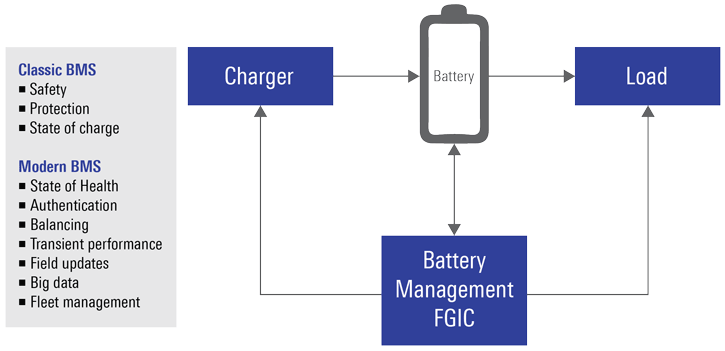Next-generation Lithium-ion battery designs need to select a battery management platform more capable than in the past. Traditional battery management has rightly prioritized battery safety; tricky Li-ion cells must maintain a stable operating state regardless of their environmental conditions. And, battery management systems have widely adopted state-of-charge measurements, a feature that brings enormous application benefits to both system designers and end users. Now though, due to the accelerating usage of Li-ion batteries in expensive high-power and high-voltage applications, the consequences of battery issues are more painful than ever and so battery management has evolved to include new requirements, features and expectations. These include state of health, authentication, balancing, transient performance, field updates, big data, and fleet management, each beneficial to larger batteries.

Modern battery management ICs now need to take on more tasks than the traditional safety, protection and SOC roles
State of Health (SOH): Measures changes to the cell efficacy over time and is variously defined by the degree of full charge capacity degradation, increases to battery impedance, tracking use conditions like total cycles, or operation under temperature or high charge and discharge current. State of health is a key tool to tell users when battery changes are required, and potentially to educate users on optimized use conditions.
Authentication: To insure system safety, higher voltage Li-ion batteries undergo extensive qualification trials and testing. The quickest way to discard this safety insurance in a system is to attach an unqualified, counterfeit battery. Authentication, either through a software algorithm like SHA or a hardware-software method like elliptic key cryptography is a key tool to minimize the risk of an unsafe battery attach incident.
Balancing: Particularly for 1P higher voltage battery modules, the probability of cell imbalances grows with the cell count. Built-in cell re-balancing will increase host system uptimes and lengthen battery life, ultimately increasing customer satisfaction.
Transient Performance: Many systems have variable loads where higher power operation is sometimes desirable. For this, the battery management system may provide critical battery state information to the host, such as battery impedance and state of charge levels, from which the battery’s maximum output power and time over which this max power is available can be calculated.
Field Updates: The implementation of new features – like state of health, or better, state of charge algorithms – can enhance the value of products already in use in the field. The battery management system should accommodate communication with the host system and a remotely programmable memory space to receive and store the firmware changes even after field release.
Big Data: Lithium-ion battery behaviors and measurable parameters are typically non-linear and both user and environment dependent. Optimizing algorithms and using recommendations like state of health and battery change frequency, can be made more accurate by tracking and analyzing the data across a big dataset of batteries in use.
Fleet Management: For a company or administrator responsible for managing many deployed batteries, such as in datacenters or electric fleet vehicles, a battery management system capable of periodically reporting changes of state through the networked host is essential so maintenance and changes can be scheduled.
The Renesas battery management portfolio, which includes battery front-end ICs, programmable MCUs, and co-packaged MCU + battery front ends, provides the ideal hardware toolset to meet all of these modern requirements. The battery front ends include a full suite of protection functions, ADC and inputs for cell and pack voltages, temperature inputs, optional dedicated ADC for coulomb counting, timers to synchronize measurements for impedance, various communication options, integrated charger and load detection circuits, integrated voltage regulators, FET drivers and more. The controllers are programmable and customizable, with I2C and other bus options, a sector of flash for battery state information data storage, and a standard set of starter code.
Regardless of whether specific functions are needed or the full suite is to be implemented, Renesas battery management products provide the best blend of hardware-specific features and design flexibility. Visit our Battery Management page to learn more and find the right product for your design requirements.
